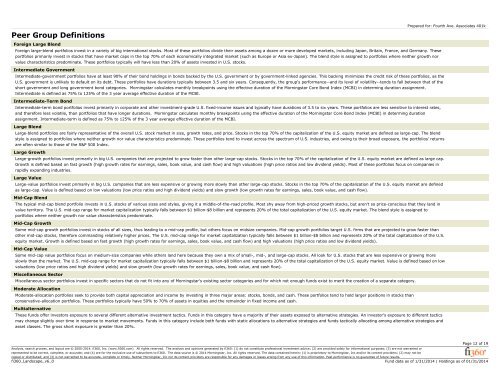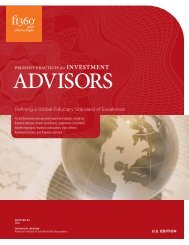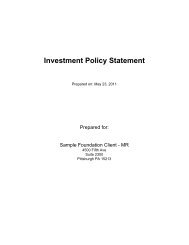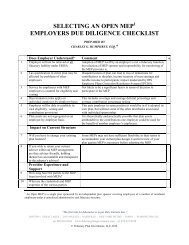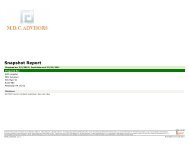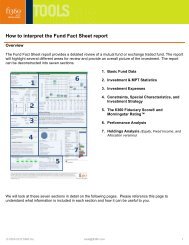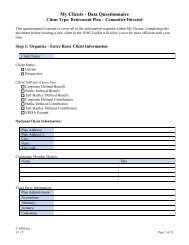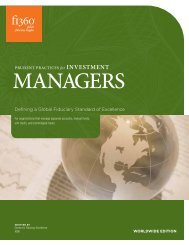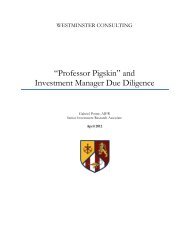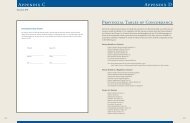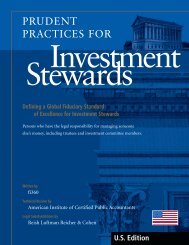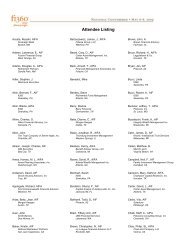404(a)(5) Participant Fee Disclosure - Fi360
404(a)(5) Participant Fee Disclosure - Fi360
404(a)(5) Participant Fee Disclosure - Fi360
You also want an ePaper? Increase the reach of your titles
YUMPU automatically turns print PDFs into web optimized ePapers that Google loves.
Peer Group Definitions<br />
Foreign Large Blend<br />
Foreign large-blend portfolios invest in a variety of big international stocks. Most of these portfolios divide their assets among a dozen or more developed markets, including Japan, Britain, France, and Germany. These<br />
portfolios primarily invest in stocks that have market caps in the top 70% of each economically integrated market (such as Europe or Asia ex-Japan). The blend style is assigned to portfolios where neither growth nor<br />
value characteristics predominate. These portfolios typically will have less than 20% of assets invested in U.S. stocks.<br />
Intermediate Government<br />
Intermediate-government portfolios have at least 90% of their bond holdings in bonds backed by the U.S. government or by government-linked agencies. This backing minimizes the credit risk of these portfolios, as the<br />
U.S. government is unlikely to default on its debt. These portfolios have durations typically between 3.5 and six years. Consequently, the group's performance--and its level of volatility--tends to fall between that of the<br />
short government and long government bond categories. Morningstar calculates monthly breakpoints using the effective duration of the Morningstar Core Bond Index (MCBI) in determing duration assignment.<br />
Intermediate is defined as 75% to 125% of the 3 year average effective duration of the MCBI.<br />
Intermediate-Term Bond<br />
Intermediate-term bond portfolios invest primarily in corporate and other investment-grade U.S. fixed-income issues and typically have durations of 3.5 to six years. These portfolios are less sensitive to interest rates,<br />
and therefore less volatile, than portfolios that have longer durations. Morningstar calculates monthly breakpoints using the effective duration of the Morningstar Core Bond Index (MCBI) in determing duration<br />
assignment. Intermediate-term is defined as 75% to 125% of the 3 year average effective duration of the MCBI.<br />
Large Blend<br />
Large-blend portfolios are fairly representative of the overall U.S. stock market in size, growth rates, and price. Stocks in the top 70% of the capitalization of the U.S. equity market are defined as large-cap. The blend<br />
style is assigned to portfolios where neither growth nor value characteristics predominate. These portfolios tend to invest across the spectrum of U.S. industries, and owing to their broad exposure, the portfolios' returns<br />
are often similar to those of the S&P 500 Index.<br />
Large Growth<br />
Large-growth portfolios invest primarily in big U.S. companies that are projected to grow faster than other large-cap stocks. Stocks in the top 70% of the capitalization of the U.S. equity market are defined as large cap.<br />
Growth is defined based on fast growth (high growth rates for earnings, sales, book value, and cash flow) and high valuations (high price ratios and low dividend yields). Most of these portfolios focus on companies in<br />
rapidly expanding industries.<br />
Large Value<br />
Large-value portfolios invest primarily in big U.S. companies that are less expensive or growing more slowly than other large-cap stocks. Stocks in the top 70% of the capitalization of the U.S. equity market are defined<br />
as large-cap. Value is defined based on low valuations (low price ratios and high dividend yields) and slow growth (low growth rates for earnings, sales, book value, and cash flow).<br />
Mid-Cap Blend<br />
The typical mid-cap blend portfolio invests in U.S. stocks of various sizes and styles, giving it a middle-of-the-road profile. Most shy away from high-priced growth stocks, but aren't so price-conscious that they land in<br />
value territory. The U.S. mid-cap range for market capitalization typically falls between $1 billion-$8 billion and represents 20% of the total capitalization of the U.S. equity market. The blend style is assigned to<br />
portfolios where neither growth nor value characteristics predominate.<br />
Mid-Cap Growth<br />
Some mid-cap growth portfolios invest in stocks of all sizes, thus leading to a mid-cap profile, but others focus on midsize companies. Mid-cap growth portfolios target U.S. firms that are projected to grow faster than<br />
other mid-cap stocks, therefore commanding relatively higher prices. The U.S. mid-cap range for market capitalization typically falls between $1 billion-$8 billion and represents 20% of the total capitalization of the U.S.<br />
equity market. Growth is defined based on fast growth (high growth rates for earnings, sales, book value, and cash flow) and high valuations (high price ratios and low dividend yields).<br />
Mid-Cap Value<br />
Some mid-cap value portfolios focus on medium-size companies while others land here because they own a mix of small-, mid-, and large-cap stocks. All look for U.S. stocks that are less expensive or growing more<br />
slowly than the market. The U.S. mid-cap range for market capitalization typically falls between $1 billion-$8 billion and represents 20% of the total capitalization of the U.S. equity market. Value is defined based on low<br />
valuations (low price ratios and high dividend yields) and slow growth (low growth rates for earnings, sales, book value, and cash flow).<br />
Miscellaneous Sector<br />
Miscellaneous sector portfolios invest in specific sectors that do not fit into any of Morningstar's existing sector categories and for which not enough funds exist to merit the creation of a separate category.<br />
Moderate Allocation<br />
Moderate-allocation portfolios seek to provide both capital appreciation and income by investing in three major areas: stocks, bonds, and cash. These portfolios tend to hold larger positions in stocks than<br />
conservative-allocation portfolios. These portfolios typically have 50% to 70% of assets in equities and the remainder in fixed income and cash.<br />
Multialternative<br />
These funds offer investors exposure to several different alternative investment tactics. Funds in this category have a majority of their assets exposed to alternative strategies. An investor's exposure to different tactics<br />
may change slightly over time in response to market movements. Funds in this category include both funds with static allocations to alternative strategies and funds tactically allocating among alternative strategies and<br />
asset classes. The gross short exposure is greater than 20%.<br />
Prepared for: Fourth Ave. Associates 401k<br />
Page 12 of 19<br />
Analysis, search process, and layout are © 2000-2014, fi360, Inc. (www.fi360.com). All rights reserved. The analysis and opinions generated by fi360: (1) do not constitute professional investment advice; (2) are provided solely for informational purposes; (3) are not warranted or<br />
represented to be correct, complete, or accurate; and (4) are for the exclusive use of subscribers to fi360. The data source is © 2014 Morningstar, Inc. All rights reserved. The data contained herein: (1) is proprietary to Morningstar, Inc and/or its content providers; (2) may not be<br />
copied or distributed; and (3) is not warranted to be accurate, complete or timely. Neither Morningstar, Inc nor its content providers are responsible for any damages or losses arising from any use of this information. Past performance is no guarantee of future results.<br />
fi360_Landscape_v6_0<br />
Fund data as of 1/31/2014 | Holdings as of 01/31/2014


